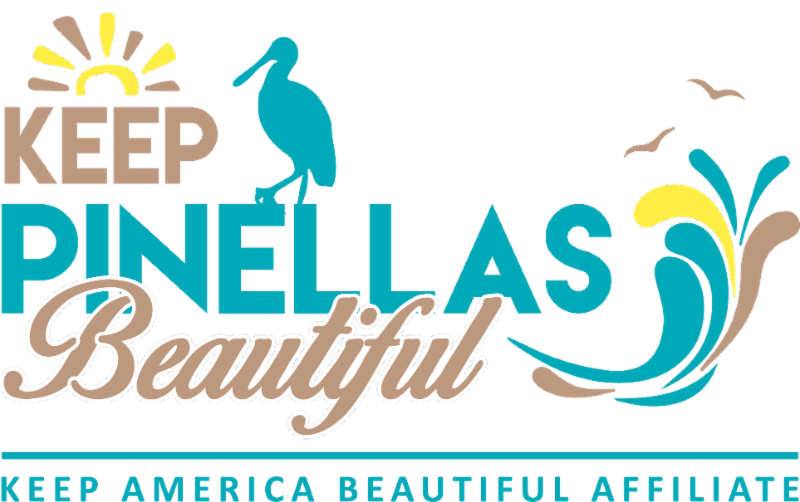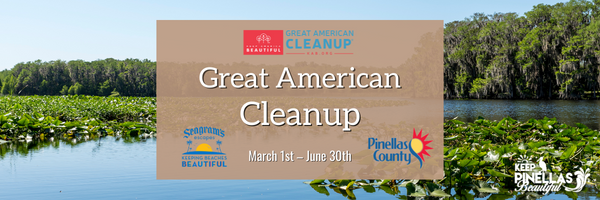Education Corner: 2023 Great American Cleanup
In this edition of Education Corner, we will talk about the Great American Cleanup and litter prevention.
Great American Cleanup
Around the nation, people will join together for the Great American Cleanup to beautify their communities and make a difference in the environment. This year, the Great American Cleanup will occur from March until June. Volunteers of all ages will assist with litter cleanup, removal of invasive species, and planting native vegetation throughout their neighborhoods, parks, and shorelines. Community action is an essential step in stopping this cycle of waste. One way that you can help is by bringing gloves and a trash bag with you on a walk so you can clean up any litter you see.
This Keep America Beautiful signature event engages over 7,000 volunteers, removing litter and beautifying locations throughout Pinellas County. KPB encourages you to join one of our upcoming events or organize a beach/park cleanup with your coworkers, friends and family. These events are wonderful ways to build team morale, improve your local environment and leave a lasting impact.
Litter Prevention
Litter is found everywhere. Litter can be found in hundreds of places such as along the side of the road, in drainage ditches and in waterways. Most of us don’t mean to litter and accidental littering (like something blowing out of your hand or getting left behind on a walk) does happen. Sadly, litter costs cities and counties thousands of dollars a year to remove and clean up areas, reduces home value prices and animals may get tangled or digest litter. We have the power to recognize and prevent litter.
These are a few ways that you can prevent litter:
Bring reusable bags when shopping and avoid plastic bags.
Carry a reusable water bottle and coffee mug.
Avoid plastic straws.
Reuse food containers/lunch bags/utensils.
Stop releasing balloons intentionally.
Dispose of cigarette butts properly.
Responsibly dispose of trash.
Set an example by not littering.
Teach others the proper way to dispose of trash.
Pick up one piece of litter every day.
Ask your family, friends and neighbors to join you in cleaning a public area where litter has accumulated.
Activity for toddlers and preschoolers
Goal: Sorting trash vs recycling
Materials: various items that are trash and recycling such as plastic bottles, cans, boxes and paper.
Directions:
Place them on the floor and discuss various concepts about recycling.
Parents can ask the child about color, sizes and shape.
Questions to ask:
What color is the bottle? Make piles of different colored items.
Can you find the largest item? Organize the recycling items by size (smallest to largest).
Discuss what items go into the trash and what items go into the recycling.
Activity for elementary school students
Goal: to understand how a marine animal may be confused by trash.
Materials:
Medium size bowl, food storage container, or tin
Lightweight cereal such as Lucky Charms or Cheerios which represents the marine debris
Crackers, marshmallows or M & M candies which represents fish or marine animals
Spoon
Water
Instructions:
Pour water in the container about half full.
Add a small handful of marine debris (cereal) into the water. Add the marine animals and fish (crackers, marshmallows or M & M candies).
Using a spoon, move the water around in circles and keep the spoon near the edges of the bowl.
Discuss what happens to the marine debris and how the marine debris breaks down into smaller pieces.
Questions to ask:
Why is marine debris a bad thing for our ocean?
What kind of items might entangle a marine animal? How?
Is there another way marine debris can hurt the ocean ecosystem or the animals living within the ocean ecosystem?
Activity for middle school students
Goal: Increase understanding of how marine life can easily mistake marine litter for food.
Materials:
1 container
Spoon
Rice
Cheerios
Sand
Cup
Instruction:
Ask the kid(s) if they want to pretend to be a fish, baby turtle or baby seabird.
Place the sand in the container. Add the rice (food) and add the Cheerios (plastic).
Explain that the animal is hungry and their food is rice floating in the ocean (container). The food has been contaminated by plastic (Cheerios).
Have them pick up the spoon with their mouths and try to get as much food as they can into the cup (stomach) trying to avoid the plastic (Cheerios).
For older kids, pour the stomach contents into a coffee filter and count how many pieces of rice and pieces of plastic they had. Create a chart/graph using your data or calculate the percentage of plastic in their diet (# plastic divided by # rice).
Questions to ask:
Did you collect more food or plastic?
How might this same situation affect marine animals like sea turtles, sea birds or marine mammals that often ingest large amounts of plastic pieces?
Did you have a hard time searching for your food? Why?
What do you think is the most common litter item in the ocean?





